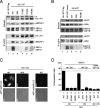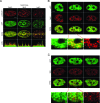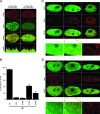In vivo study of the nucleosome assembly functions of ASF1 histone chaperones in human cells
- PMID: 18378699
- PMCID: PMC2423286
- DOI: 10.1128/MCB.00510-07
In vivo study of the nucleosome assembly functions of ASF1 histone chaperones in human cells
Abstract
Histone chaperones have been implicated in nucleosome assembly and disassembly as well as histone modification. ASF1 is a highly conserved histone H3/H4 chaperone that synergizes in vitro with two other histone chaperones, chromatin assembly factor 1 (CAF-1) and histone repression A factor (HIRA), in DNA synthesis-coupled and DNA synthesis-independent nucleosome assembly. Here, we identify mutants of histones H3.1 and H3.3 that are unable to interact with human ASF1A and ASF1B isoforms but that are still competent to bind CAF-1 and HIRA, respectively. We show that these mutant histones are inefficiently deposited into chromatin in vivo. Furthermore, we found that both ASF1A and ASF1B participate in the DNA synthesis-independent deposition of H3.3 in HeLa cells, thus highlighting an unexpected role for ASF1B in this pathway. This pathway does not require interaction of ASF1 with HIRA. We provide the first direct determination that ASF1A and ASF1B play a role in the efficiency of nucleosome assembly in vivo in human cells.
Figures






Similar articles
-
The histone chaperone Asf1 is dispensable for direct de novo histone deposition in Xenopus egg extracts.Chromosoma. 2007 Oct;116(5):487-96. doi: 10.1007/s00412-007-0112-x. Epub 2007 Jun 19. Chromosoma. 2007. PMID: 17576589
-
Phosphorylation of H4 Ser 47 promotes HIRA-mediated nucleosome assembly.Genes Dev. 2011 Jul 1;25(13):1359-64. doi: 10.1101/gad.2055511. Genes Dev. 2011. PMID: 21724829 Free PMC article.
-
ASF1 is required to load histones on the HIRA complex in preparation of paternal chromatin assembly at fertilization.Epigenetics Chromatin. 2018 May 11;11(1):19. doi: 10.1186/s13072-018-0189-x. Epigenetics Chromatin. 2018. PMID: 29751847 Free PMC article.
-
The histone chaperone Asf1 at the crossroads of chromatin and DNA checkpoint pathways.Chromosoma. 2007 Apr;116(2):79-93. doi: 10.1007/s00412-006-0087-z. Epub 2006 Dec 19. Chromosoma. 2007. PMID: 17180700 Review.
-
Histone chaperones, a supporting role in the limelight.Biochim Biophys Acta. 2004 Mar 15;1677(1-3):3-11. doi: 10.1016/j.bbaexp.2003.09.012. Biochim Biophys Acta. 2004. PMID: 15020040 Review.
Cited by
-
The histone chaperoning pathway: from ribosome to nucleosome.Essays Biochem. 2019 Apr 23;63(1):29-43. doi: 10.1042/EBC20180055. Print 2019 Apr 23. Essays Biochem. 2019. PMID: 31015382 Free PMC article. Review.
-
Tousled kinase TLK1B mediates chromatin assembly in conjunction with Asf1 regardless of its kinase activity.BMC Res Notes. 2010 Mar 11;3:68. doi: 10.1186/1756-0500-3-68. BMC Res Notes. 2010. PMID: 20222959 Free PMC article.
-
Epigenetic Regulation of Cellular Senescence and Aging.Front Genet. 2017 Sep 26;8:138. doi: 10.3389/fgene.2017.00138. eCollection 2017. Front Genet. 2017. PMID: 29018479 Free PMC article. Review.
-
Chromatin remodeling of histone H3 variants by DDM1 underlies epigenetic inheritance of DNA methylation.Cell. 2023 Sep 14;186(19):4100-4116.e15. doi: 10.1016/j.cell.2023.08.001. Epub 2023 Aug 28. Cell. 2023. PMID: 37643610 Free PMC article.
-
Tousled-like kinase-dependent phosphorylation of Rad9 plays a role in cell cycle progression and G2/M checkpoint exit.PLoS One. 2013 Dec 20;8(12):e85859. doi: 10.1371/journal.pone.0085859. eCollection 2013. PLoS One. 2013. PMID: 24376897 Free PMC article.
References
-
- Adkins, M. W., and J. K. Tyler. 2004. The histone chaperone Asf1p mediates global chromatin disassembly in vivo. J. Biol. Chem. 27952069-52074. - PubMed
-
- Agez, M., J. Chen, R. Guerois, C. van Heijenoort, J. Y. Thuret, C. Mann, and F. Ochsenbein. 2007. Structure of the histone chaperone ASF1 bound to the histone H3 C-terminal helix and functional insights. Structure 15191-199. - PubMed
-
- Ahmad, K., and S. Henikoff. 2002. The histone variant H3.3 marks active chromatin by replication-independent nucleosome assembly. Mol. Cell 91191-1200. - PubMed
Publication types
MeSH terms
Substances
LinkOut - more resources
Full Text Sources
Other Literature Sources
Miscellaneous
